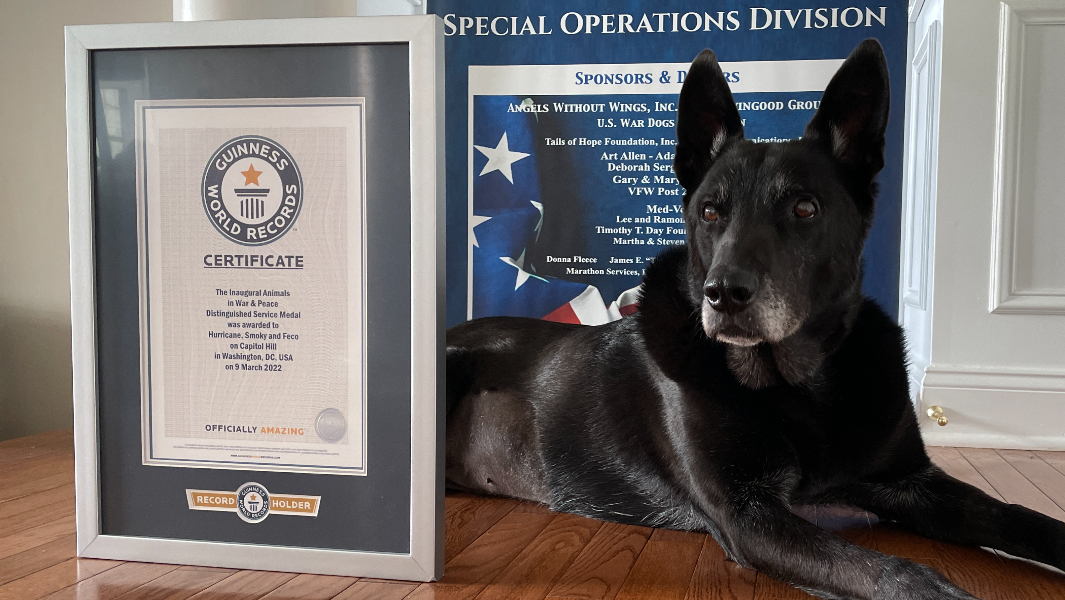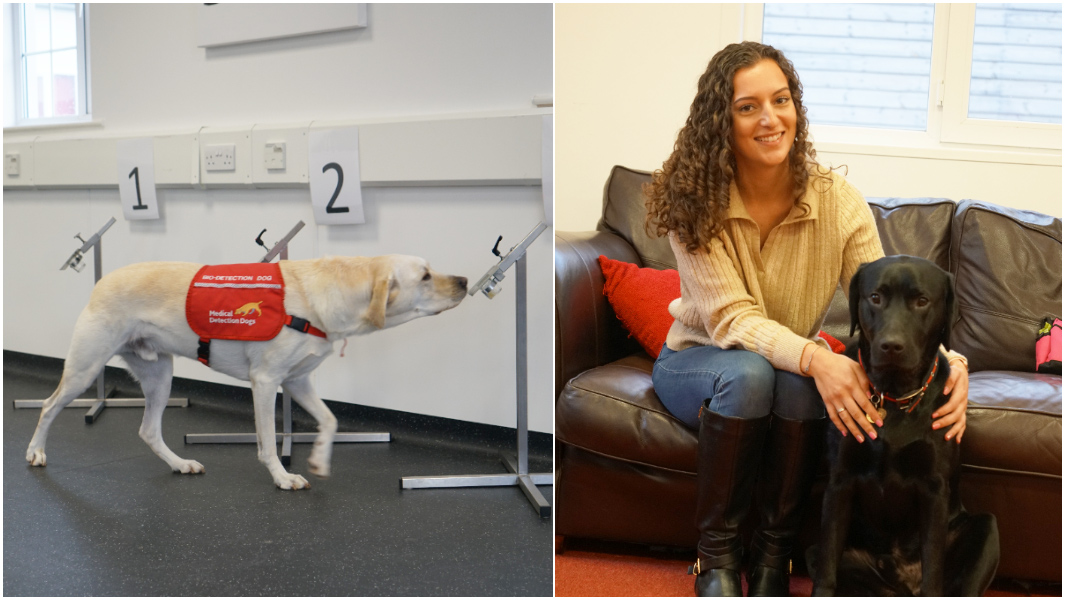


A quick response can save a life, and the su-paw-stars at Medical Detection Dogs (MDD) know that better than anyone.
A growing pack of volunteer bio-detection dogs work and play with a team of certified trainers at this UK-based charity, sharpening their incredible olfactory abilities in order to detect illnesses.
Playing a key role in saving lives through the sense of smell, these four-legged heroes are at the cutting-edge of medical research.
In February 2022, Medical Detection Dogs officially broke their first record for most medical conditions detected by dogs (organisation) – with a total of 28 diseases since the charity was founded in 2008.
The portfolio of medical conditions that MDD has been able to train their dogs to sniff out is far ranging, including everything from nut allergies, variations in blood glucose (e.g., diabetes), malaria, several forms of cancer and heart conditions. More recently, COVID-19 was added to that list.
That result, which landed them a spot in Guinness World Records 2023, was only the beginning of their record-breaking journey.
In November 2022, the charity embarked on a mission to set a second bio-detection record.
“I’m very confident we are going to smash it today,” said bio-detection trainer Olivia James at Medical Detection Dogs just before the attempt. “I love the dogs and they love their job, so I’m sure they are going to make us proud.”
During the simulation, the challenge was to pinpoint the presence of different medical conditions, with the dogs tasked with sniffing out their designated diseases from several samples (these could be based on urine, saliva or breath).
The dogs were required to correctly detect Parkinson's disease, prostate cancer, Pseudomonas infection, postural tachycardia syndrome (PoTS) and – perhaps the most pre-eminent illness of recent times – COVID-19.

And what a triumph it was!
Five dogs along with two trainers (Olivia, and training coordinator Mark Somerville) teamed up to officially fetch the record for the most consecutive medical samples identified by dogs: the talented hounds correctly identified 24 samples in a row. Tensions soared at Run #19 when Lexi got a little distracted but as she indicated none of the samples, which was considered a “pass” rather than a misidentified sample.
The five talented canines who set the record were:
Through several training sessions, all five dogs honed their outstanding olfactory abilities to spot a different disease. After careful inspection of the samples, each dog has its own special way of making it clear that they have found their match. This might involve abruptly halting in front of a sample, sitting down in front of it, and often seeking their trainer’s gaze to confirm they are done and seeking a treat.
Then, showered in praises and attention after every success they bag, the dogs could celebrate the well-deserved certificate with lots of playtime and cuddles.

Domesticated dogs have played a role in society for millennia, and their sniffing abilities have proved to be key since the Middle Ages. Their ability to sense diseases started breaking records as early as 1989 during the first reported case of canine cancer detection.
On that occasion, the medical journal The Lancet detailed the case of trainee dermatologists Hywel Williams and Andres Pembroke.
A dog’s continual interest in a mole on his owner's leg led her to seek medical advice, unveiling a case of malignant melanoma and leading to early treatment.
Although the importance of canine inclusion in the medical field might have gone undetected, since 2008 Medical Detection Dogs have placed their faith in the best biosensor we know of: a dog’s nose.
For the last few years, the Buckinghamshire-based charity has strived continuously to train dogs to become game-changer in the fight against illnesses.
“What we have learned over many centuries is that different diseases have unique odours. We now know that dogs, with their incredible noses, can be trained to find these diseases,” says Dr Claire Guest, Co-Founder, CEO and Chief Scientific Officer of Medical Detection Dogs.
It’s no surprise to hear that our beloved four-legged friends have incredible noses, already widely renowned and used in other circumstances (think of truffle-hunters and search-and-rescue dogs).
What not every dog-lover might know, however, is that they can count on around 300 million olfactory receptors, which makes their sense of smell between 10,000 and 100,000 times more acute than a human’s.
“We can perhaps smell a spoonful of sugar in a cup of tea, a dog can smell a teaspoon of sugar in the equivalent of two Olympic swimming pools.” - Dr Claire Guest

Their ability to sniff an illness but also to sense the subtlest change in any odour -- picking up changes of around one part per trillion -- makes canine contribution essential in life-threatening situations when drastic changes in a patient’s health need to be spotted with as much advance as possible.
That allows these su-paw-stars to detect the tiniest trace of human diseases and save lives – sometimes, by mere seconds. Acting timely is incredibly important, and these record-breaking pups know it well.
In 2014, Medical Detection Dogs – thanks to collaboration with researchers and academic institutions in and out of the UK – were able to indicate that the dogs could become highly trained disease detectors, as well as faithful companions for people suffering from certain illnesses.
“But what is incredibly important to us is dog welfare,” Dr Guest highlights.
“It’s absolutely important that our dogs love what they are doing. For them, is a bit of a game. We are also able to use rescue and unwanted dogs, at times. They love what they do, and then they go home and curl up on the sofa like any other dog. It’s a win-win situation.”
“We have placed over 150 dogs around the United Kingdom working with individuals with life-threatening conditions, and we have 40 dogs working in sample detection projects.”
More than a hundred pups are also waiting in the wings, waiting to learn and leave their mark in history and change countless lives.
“In both cases the dogs are using their sense of smell, although in slightly different ways.”

Although all dogs boast an incredibly developed sense of smell, some breeds seem to excel when it comes specifically to sniffing out illnesses.
“Generally speaking, we use a lot of breeds that have been bred traditionally to use their sense of smell but also to work alongside men,” says Dr Guest.
“You’ll see a lot of Labradors, here, a lot of spaniels and a lot of Lab-spaniel crosses. But we can use other breeds – for example, we had German shorthaired pointers, and we’ve got poodles. We also have a wire-haired dachshund, a breed not traditionally known for their nose, though we have to lower the samples closer to the ground for him!”
“All our dogs need to be determined, and happy, and they have to love investigating.”
As well as working with bio-detection dogs, the charity also plays another crucial role in the training of medical-alert assistance dogs.
These animals are placed in loving homes with owners who live under the constant threat of a sudden episode, which has the potential to be deadly (e.g., consider unexpectedly blacking out while driving or walking down some stairs).
As such, the sniffing abilities of these dogs give people with high-risk conditions peace of mind and essentially open up their lives.
The dog will be noticing fluctuations in their owner’s particular “smell print”, sensing a variation and empowering the owner to act before the episode escalates into an emergency,” Dr Guest explains.

One such condition that MDD have worked with is postural tachycardia syndrome, also known as postural orthostatic tachycardia syndrome (PoTS for short).
This condition causes an abnormal spike in the heart rate after sudden movements like sitting down or standing up.
Although many people might experience a “head rush” after such movements, for PoTS patients the extreme changes in heart rate can result in acute dizziness and fainting.
“With PoTS, for example, the patient has no awareness at all that they are going to immediately collapse and blackout,” says Dr Guest.
“Incredibly, the dogs give a three-to-five-minute warning. That means the person can make themselves safe and prevent hospital admission.”
 >
>
That’s the case of Demi Mant, who lives with PoTS. She was matched with a beautiful black Labrador called Bear through Medical Detection Dogs in early 2022.
From the first moment you meet them, it’s clear that Demi and Bear share a unique bond based on mutual trust and endless love.
“My heart rate can go very high or very low, and I can experience pauses and skipping beats as well. My heart just does things which it shouldn’t really do,” Demi explains.
That means she can faint at any moment, injuring herself. Bear has been trained to give her a four-to-five-minute warning before an episode when she’s at risk, allowing Demi to sit or lie down, preventing accidents.
With a smile, Demi confesses that the eight months they spent together so far have drastically improved her day-to-day life.
“Before I met him, he already had his behavioural training. He had been taught to pick up items: so, if I dropped my phone or keys to the floor, he was trained to pick those up for me,” she reveals. Although for most people this skill might seem rather trivial, it’s essential when a change of posture and even bending down to pick up a dropped item can cause a patient to faint.
“Although it’s only been a few months, Bear has had a massive impact on my life.” - Demi

Demi recounts her difficulties at university, which she was forced to end early, when her condition had yet to be diagnosed.
“I looked at my life and I felt I was losing everything. Anything that was good, I seemed to lose.”
But now with Bear in her life, things could not be more different: “I look back at this year and I know that I’ve done so many things I couldn’t have done without him with me. I have the confidence to go out and do little things by myself – like going shopping. Before I would take my mum because I knew it was a place where I was quite likely to have an episode and pass out.”
Demi is also a dancer and runs her very own school.

Unsurprisingly, Bear’s presence has made a huge difference in that area of her life too.
“Before I would cancel appointments if I was having an off-day. Now I have the confidence to go on with my day even if it’s an off-day instead of writing it out completely.”
A big pup through and through, whenever he’s off duty Bear is very playful and loves cuddly toys: “he has the biggest collection,” Demi says [Ed: whether it’s a record, still pending!].
He also loves water, and he and Demi often visit a local stream to play whenever they can.
However, despite loving all the things a regular dog likes and enjoying a comfortable life, Bear is a tireless worker: he will never miss an alert and, even at night, he’ll notify his owner immediately if she’s in danger.
“With Bear, everything is okay.”
Want more? Follow us across our social media channels to stay up-to-date with all things Guinness World Records! You can find us on Facebook, Twitter, Instagram, TikTok, LinkedIn, and Snapchat Discover– including our in-depth Curious Casebook series.
Don’t forget, we’re also on YouTube!
Still not had enough? Follow the link here to buy our latest book, filled to the brim with stories about our amazing record breakers.